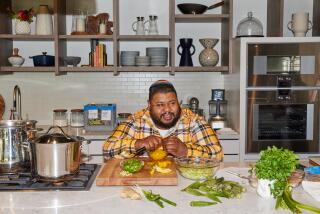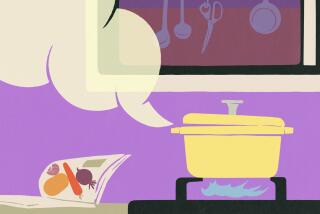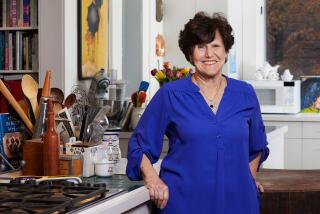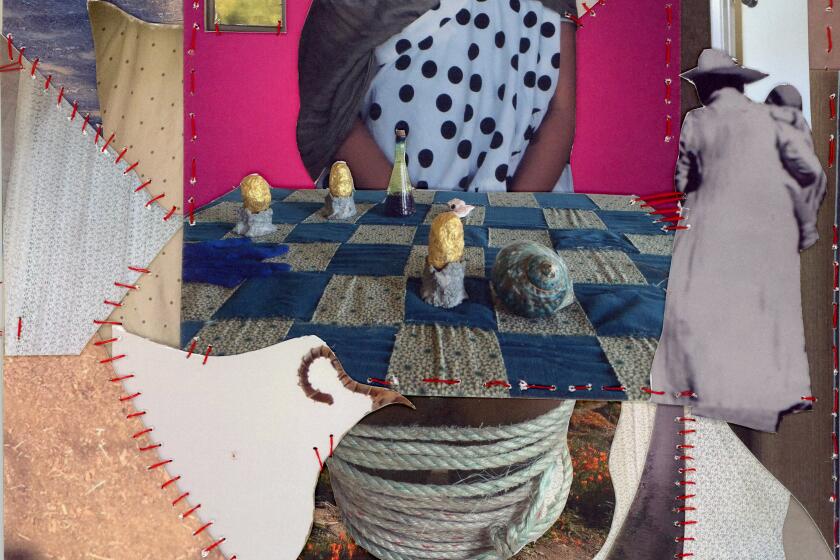Welcome to the poet’s table
IF Maya Angelou likes you, even just a bit, she wants to cook for you.
The 76-year-old celebrated writer and poet invests something personal in each dish, whether for the hungry stranger walking into the San Francisco joint where she slung Creole hash as a 17-year-old or for the famous friends to whom she still serves smothered chicken and spoon bread. It’s a quality she learned early at her grandmother’s table.
The stories of the most memorable of those meals — including recipes handed down from her grandmother and mother and across the table from her sister-friends — are chronicled in her just-published cookbook, “Hallelujah! The Welcome Table: A Lifetime of Memories With Recipes.”
“Food is important not just as fuel for the body, but as devices for the growth of the soul,” says Angelou over lunch at Hal’s in Venice, a restaurant she calls her “joint” when she’s on one of her frequent visits to L.A.
Having learned to cook from a grandmother born into slavery who labored her whole life over a wood-burning stove, Angelou’s passion for food is flavored with respect for what it took for her forebears to create the dishes she loves.
“The slaves were given the worst things — the livers, the lungs, gizzards and feet. To make those into delicious things ahhhh,” she says with a smile. “Have you ever had hog-head cheese? You must make it. You make it with pickled pigs’ feet.”
That recipe from her grandmother Annie Henderson, whom she called Momma, is in her cookbook.
The peek into Momma’s kitchen is what makes this cookbook so compelling.
“With almost nothing, if you care, you can make something. That’s the lesson of African American cuisine,” says Angelou.
With that, she launches into the story of the caramel cake.
“Mind you now, Momma made that cake on a wood-burning stove. She didn’t have brown sugar. She had to make everything. Had to have the fire at a particular heat. To hold the heat, she had to know when to put in another piece of wood, when to put in a piece of pine wood that would burn fast for a rush of heat, or a piece of walnut, for a slower burn. And the different kinds of woods would give you different flavors in your food. It was a science. An artful science,” says Angelou.
Needless to say, Momma made her caramel cake on rare occasions.
As a child, Angelou became mute for a time after a period of sexual abuse — the subject of her acclaimed autobiographical story, “I Know Why the Caged Bird Sings.”
At her grandmother’s table in Stamps, Ark., she began her recovery.
One day, young Maya was slapped across the face by a teacher with no tolerance for a child who could, but would not, speak. Angelou’s furious grandmother returned that slap to its owner and, later, salved the child’s hurt with her famous butter and sugar confection.
“She knew just what to do for everything,” says Angelou. “And it would always have to do with food.
“My grandmother used to braid my hair. African hair has a part that is flat and a part that is round. Because of the round, it curls. If the person is sick or not eating properly, it will break. Whenever my grandmother braided my hair, she would take a strand of hair out of the brush. If it would break, my grandmother would gasp, ‘Oh sister, Momma’s got to make you some greens,’ ” recalls Angelou.
“I’d go out to the garden and she’d tell me what greens to get. Then she would put on a big starched apron, and she’d go into the woods and come back with maybe five leaves of something tucked in the apron. She’d cook the greens with some bark, a streak of fat and then put her mysterious things from the woods in there. And,” Angelou erupts in laughter, “my hair would strengthen.”
While Angelou now lives in Winston-Salem, N.C., and has a place in New York City, she has called Los Angeles home off and on since the 1950s. “I lived all over. On 5th Avenue near Exposition, in Pacific Palisades, the Lake district, Santa Monica, Laurel Canyon.”
She discovered her love of Mexican food here. And she sought out the Creole restaurants near her Exposition neighborhood.
At Hal’s, a brasserie with few pretensions but a hip ambience and lots of regular customers, Angelou orders green salad and roasted chicken. Before she lifts her fork, she pauses for a silent prayer, so brief that her lunch partner continues to chatter away.
She accepts a quick apology and explains why she says grace.
“It stops everything for a moment and reminds me that I am about to eat something wonderful and I’m blessed to have it because there are so many people in the world who do not have it. It allows me to say thank you.
“I’ve lived in varying places in the world, and when I come home and see the reckless abandon we display with our largess, I’m so sorry. We don’t approach food with the respect that it deserves,” says Angelou.
At her own dinner table, Angelou refuses to tolerate such attitudes. Anyone with a lack of appreciation for the food and the joyful spirit of the meal is handed his coat and shown the door.
*
Caramel cake
Total time: 1 hour, 20 minutes
Servings: 8 to 10
Note: Adapted from “Hallelujah! The Welcome Table,” by Maya
Angelou
Caramel syrup
1 cup sugar
1 cup boiling water
1. Heat the sugar in a heavy skillet over low heat. Stir constantly until it is melted to a brown liquid. When it bubbles over its entire surface, about 20 minutes, remove from the heat.
2. Slowly add the boiling water, stirring constantly. Pour into a container and cool. Use one-fourth cup for the cake; save the rest for another use.
Caramel frosting
1/2 cup (1 stick) plus
1 tablespoon butter
3 cups powdered sugar
6 tablespoons heavy cream
1 1/4 teaspoons vanilla extract
Pinch of salt
1. Brown the butter in a heavy pot over medium heat — be vigilant or it will burn. Allow the butter to cool.
2. Pour the cooled butter into a large mixing bowl. Add the powdered sugar, cream, vanilla and salt and beat until smooth. If the frosting is too stiff, add a tablespoon of half-and-half or cream.
Cake and assembly
1/2 cup (1 stick) butter
1 1/4 cups sugar, divided
1/4 cup caramel syrup
2 cups sifted all-purpose flour
2 teaspoons baking powder
1/2 teaspoon salt
1 cup milk
2 large eggs
1 recipe caramel frosting
1. Heat the oven to 375 degrees. Line the bottoms of two 8-inch layer cake pans with greased wax paper.
2. In a large mixing bowl, cream the butter and gradually add 1 cup sugar, beating until light and fluffy. Beat in the syrup.
3. In a medium mixing bowl, sift the flour, baking powder and salt together. Add the sifted ingredients to the creamed mixture, alternating with the milk.
5. In a separate medium mixing bowl, beat the eggs about 3 minutes, until foamy. Add the remaining sugar and beat until mixture resembles a fine spongy foam, another 3 minutes. Stir it into cake batter until blended.
6. Divide the batter between the cake pans. Bake for about 25 minutes. Check by gently pressing the center of a cake; it should spring back. If it doesn’t, bake for 10 more minutes. Cool in the pans for 10 minutes, then on a rack before frosting with caramel frosting. Refrigerate until ready to serve.
Each serving: 637 calories; 6 grams protein; 98 grams carbohydrates; 1 gram fiber; 26 grams fat; 15 grams saturated fat; 122 mg. cholesterol; 300 mg. sodium.
More to Read
Sign up for our L.A. Times Plants newsletter
At the start of each month, get a roundup of upcoming plant-related activities and events in Southern California, along with links to tips and articles you may have missed.
You may occasionally receive promotional content from the Los Angeles Times.






